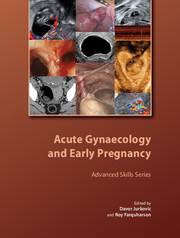Book contents
- Frontmatter
- Contents
- About the authors
- Acknowledgements
- Abbreviations
- Preface
- 1 Organisation and delivery of emergency care in early pregnancy and acute gynaecology
- 2 Epidemiology and aetiology of miscarriage and ectopic pregnancy
- 3 Diagnosis of miscarriage
- 4 Conservative and surgical management of miscarriage
- 5 Management of hyperemesis gravidarum
- 6 Diagnosis and treatment of recurrent miscarriage
- 7 Differential diagnosis and management of molar pregnancy
- 8 Drugs in early pregnancy
- 9 Diagnosis of tubal ectopic pregnancy
- 10 Conservative management of tubal ectopic pregnancy
- 11 Surgical management of tubal ectopic pregnancy
- 12 Diagnosis and management of non-tubal ectopic pregnancy
- 13 Diagnosis and management of acute pelvic pain
- 14 Management of vaginal bleeding in the acute clinical setting
- 15 Current concepts in screening and outpatient management of pelvic inflammatory disease
- 16 Diagnosis and management of haemorrhagic and septic shock
- 17 Role of minimally invasive surgery in acute gynaecology
- Index
3 - Diagnosis of miscarriage
Published online by Cambridge University Press: 05 July 2014
- Frontmatter
- Contents
- About the authors
- Acknowledgements
- Abbreviations
- Preface
- 1 Organisation and delivery of emergency care in early pregnancy and acute gynaecology
- 2 Epidemiology and aetiology of miscarriage and ectopic pregnancy
- 3 Diagnosis of miscarriage
- 4 Conservative and surgical management of miscarriage
- 5 Management of hyperemesis gravidarum
- 6 Diagnosis and treatment of recurrent miscarriage
- 7 Differential diagnosis and management of molar pregnancy
- 8 Drugs in early pregnancy
- 9 Diagnosis of tubal ectopic pregnancy
- 10 Conservative management of tubal ectopic pregnancy
- 11 Surgical management of tubal ectopic pregnancy
- 12 Diagnosis and management of non-tubal ectopic pregnancy
- 13 Diagnosis and management of acute pelvic pain
- 14 Management of vaginal bleeding in the acute clinical setting
- 15 Current concepts in screening and outpatient management of pelvic inflammatory disease
- 16 Diagnosis and management of haemorrhagic and septic shock
- 17 Role of minimally invasive surgery in acute gynaecology
- Index
Summary
Introduction
Miscarriage is the most common complication in early pregnancy. It occurs in 15% of clinically recognised pregnancies and accounts for 50 000 inpatient hospital admissions each year in the UK. In recent years early pregnancy units have been designed to improve the quality of service in the diagnosis of early pregnancy complications and provide rapid and accessible care.
The prevalence of miscarriage in early pregnancy units varies from 17% to 46%. The management of women with suspected or confirmed miscarriage is the main task for medical professionals with an interest in providing early pregnancy care. The introduction of ultrasound into routine clinical practice has greatly improved the diagnosis and management of early pregnancy complications. However, easier access to dedicated early pregnancy services has also led to an increasing number of women seeking advice at early gestations. The main challenge in the provision of modern early pregnancy care is balancing the need for sympathetic and individualised care of women who have suffered early pregnancy loss with the need to manage a large number of patients on a routine daily basis.
Terminology
A miscarriage can be defined as a pregnancy failure occurring before the completion of 24 weeks of gestation, which is the current threshold for fetal viability. Miscarriages are classified as early (less than 12 weeks of gestation) or late (from 12 to 24 weeks of gestation).
- Type
- Chapter
- Information
- Acute Gynaecology and Early Pregnancy , pp. 23 - 36Publisher: Cambridge University PressPrint publication year: 2011
- 1
- Cited by



